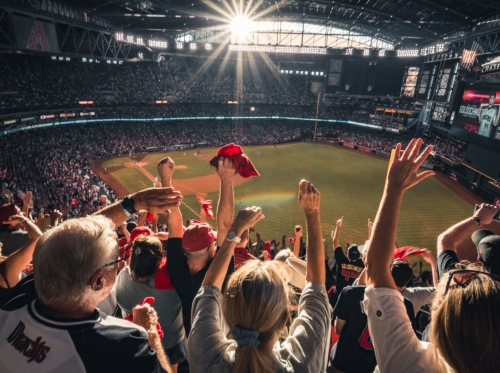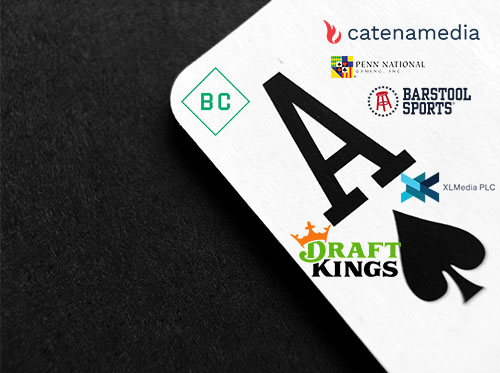KSI vs. Logan Paul Rematch: The Most Aggressive New Bet in Sports Media
What Happened?
Last month DAZN, the London-based sports streaming service backed by billionaire Len Blavatnik, debuted the first of two Snapchat shows. The shows were intended to help reach new, younger fans and educate them about the high quality talent and fight programming on DAZN, including the recent Saturday November 9th LA Staples Center rematch between online creators Logan Paul and KSI.
KSI won the six round rematch in a split decision (their first fight back in 2018 was a majority draw), but for the Rockwater team, the results in the ring were far less intriguing than the fight’s digital marketing strategy and future trend signaling.
Why Is It Interesting?
With this fight, DAZN became one of a few early experimenters in how tentpole live events can drive subscriptions to a DTC platform, and how omnichannel storytelling across free-to-access digital channels can generate the top-of-funnel awareness and audience fervor that ultimately leads to a diverse set of revenue generating transactions.
And, while DAZN’s youth-focused content marketing strategy alone provides a fascinating SVOD UA case study, the added context around DAZN’s backers and ambitions makes this story pop even more. We’ll start with the latter before venturing into the former.
Beyond a Doubt, DAZN is the Most Aggressive New Bet in Sports Media.
DAZN has spent billions on sports broadcasting rights in a variety of worldwide territories, including $1bn with Matchroom Boxing and $365mm with boxer Canelo Alvarez. The 2016-founded sports streamer is likely making the most aggressive new bet in sports media, with ambitions to be the “Netflix of sports” and to upstage Disney’s ESPN+ (earlier this year Forbes estimated DAZN at 4mm subscribers, while Disney’s ESPN+ subscribers is reported at 2mm).
Like any other capital-intensive streamer bet, it’s critical that DAZN is successful in driving rapid near and mid term subscriber growth so that (1) its content acquisition costs can be spread over an increasingly large customer base, eventually resulting in positive margins, and (2) the company can continue to procure funding from existing and prospective investors, as cash is king in supporting this land grab approach, particularly considering the incumbent competition (to this point, DAZN is currently in the market seeking a new $500mm investment, as its billionaire owner has made it clear he wants outside capital and does not plan to solely fund the new sports venture).
With a need for an exciting investor story, and future success contingent on rapid user growth, it’s no surprise that DAZN is placing a big bet on youth (aka the audiences of tomorrow). And, irrespective of DAZN’s ability to recoup its billion $$ sports rights spending spree, we believe DAZN’s content and marketing plan to activate new, younger consumers is one where industry operators must take note.
An OMG Moment that Interwove Social-Personality-Content-Experiential into a Money Making Bonanza.
DAZN’s fight schedule over the past few weeks included a rematch between YouTube stars Logan Paul and KSI. As a reminder, it was estimated that the pair’s first YouTube boxing match generated over $11mm in revenue, including 770k paid YouTube live streams @ $10 / PPV stream, as well as 20k live match attendees in London (NOTE: this estimate excludes merch and ads / sponsorships, and also doesn’t take into account the value of helping launch Jake Paul’s new RNBO clothing brand).
The massive popularity of these online personalities and proven ability to convert fans into paying customers was highly appealing to DAZN, whose quest for rapid subscriber growth led to its recent socially native awareness and sign-up campaigns targeted at younger demos.
These efforts included two DAZN Snapchat shows, the second of which ran in late October and early November in support of the Paul-KSI rematch (for reference, Snapchat’s self serve ad-buying tool estimates over 10mm US fight and wrestling fans on its platform). Further, Logan Paul released a 40 minute documentary on YouTube that was viewed over 5mm times, and KSI released a slew of promotional videos on his YouTube channel, with each generating between 3-10mm each (Paul and KSI each have over 20mm YouTube channel subscribers). These promotional content campaigns and surrounding hype culminated in a sold out event at the LA Staples Center, and a result tweet from DAZN USA’s Twitter account that generated more than 126k user interactions.
Anyone in the online content and influencer marketing industries knows that YouTube views and tweet engagements don’t directly translate to monetization success, so we’re very curious to know how effective these efforts actually were in driving younger viewers to new DAZN subscriptions. It would have been a very smart move to have personalities Paul and KSI directly incentivized in their DAZN partnership deals to drive viewership and downloads…and that seems to be the case, and much to the delight of DAZN executives.
Show Me the $$!
The CA State Athletic commission reported that each personality was guaranteed a purse of $900,000, with additional reports that the duo will split proceeds 50/50 from ticket sales, PPV buys and DAZN subscriptions. And just like the first fight, each camp likely realized seven figures in merch and ad / sponsorship revenue from the outsized media attention.
Big earnings for the fighters bodes well for DAZN…Joseph Markowski, the EVP of DAZN North America, called the fight a “big success”.
Joseph continued, “The KSI vs Logan Paul event generated a significant boost in subscriptions, caught the attention of mainstream media and introduced the sport of boxing to a completely new audience. Those were our goals at the outset and we are very pleased with the results.”
It’s late on Monday night so we will not attempt to estimate sign-ups, so we’ll instead err on the side of simple arithmetic to calculate DAZN win scenarios.
At a price of $99 / year and an assumed 5 year customer relationship, each 2,000 of net signups (post churn) equates to ~$1mm of gross revenue. Now, imagine those relationships endure for 20+ years, users become accustomed to paying a premium for tentpole events, a powerful referral program is put in place and the pre-filled credit card relationship makes it easy to market a wide variety of products…pile on multiple other monetization ideas, and one can see the high potential LTV of DAZN’s newly acquired customer base.
But Wait…Haven’t We Seen This Before?
This strategy of using free content on broadly distributed platforms to generate buzz and build narrative tension around a pay-walled event isn’t new. It’s been at the heart of WWE’s strategy for decades, and Barstool Sports has incorporated a similar approach with its “Rough and Rowdy” events.
But, 4Q 2019 is a unique media inflection point – the massive new streamer bets are disrupting and cannibalizing core business media models, putting incredible amounts of investor capital at play (/risk) and making marketing strategies that much more critical to get uniquely right.
Therefore, as the worlds of sports and entertainment continue to converge around a growing number of DTC platforms battling for supremacy, we expect both platforms and rights-owners to continue pursuing this top-of-funnel UA strategy of cross-platform storytelling and transacting. And, for many new development to rapidly emerge.
The Future of Eventized Sports Programming.
The Paul-KSI fights are over, but the trend of using live events to drive early-stage subscription growth is just beginning to heat up.
After KSI declined Logan Paul’s challenge to another rematch, and after some (likely pre-meditated) KSI prompting, Paul turned his attention, and that of his 20mm YouTube followers, to possible fights with former WWE superstar CM Punk and Bellator MMA fighter Dillon Danis.
I remember talking with industry friends about the original Paul-KSI fight, and how many a Hollywood bosses were quickly trying to figure out how they could produce their own eventized programming with online creators. We’re fans of this trend, and would like to see some thoughtful evolution of the business model (“The Match” between Tiger Woods and Phil Mickelson, and the more recent “MGM Resorts The Challenge: Japan Skins” are good examples from the golf world).
Some RockWater Predictions / Recommendations:
-
Dedicated mobile apps where fans can buy digital goods that inspire and support the training efforts of their backed fighters.
-
Gamification where promotional social mentions by fans unlocks gated BTS training and post match content.
-
Edu-tainment that allows fans to train ‘alongside’ their fighters (consider hardware + SAAS platforms like Peloton) and track their get-in-shape goals via branded wearable tech linked to the dedicated mobile apps.
-
Fans can consume their backed fighter’s same supplements and dietary regime (fighter-branded or via affiliate partnerships).
-
More and more niche SVODs will deploy this eventized strategy to drive sign-ups, and for the right A+ talent personalities and format ideas, we may even see the big SVODs play here as well (or at least test the format before doing something crazy like licensing rights to the SuperBowl 😉
And as it relates to driving SVOD subscribers, an oft-discussed topic with the large social platform business development teams is how the social juggernauts best play in the premium SVOD landscape.
The answer is NOT YouTube Red (now defunct) vis-a-vis Netflix, but instead YouTube Channel Memberships as a low friction top-of-funnel UA strategy that can preview big SVOD content to younger audiences, and then help migrate these audiences down funnel and into eventual paying users. The content pie and funnel is big, and the growing array of platforms must work together to extract the most economic value by delighting customers in all the places they discover and consume content.
We haven’t seen any great cross social platform-big SVOD initiatives here yet, though we continue to evangelize this idea to our platform friends. Teasers of similar (and smart) thinking along these lines include Facebook’s new SVOD re-seller marketplace for partners like Tastemade and MotorTrend (better audience-product alignment compared to the Amazon Prime Channels marketplace for these streamers), though we at RockWater get more excited for partnerships with the likes of Disney+, HBOMax, Netflix, etc.
But we digress.
The (Final) Conclusion
As excited as we are for what’s to come, we are also aware that we must prep ourselves for some very derivative and uninspiring efforts in the new year. But, the industry must take a few swings (and a few blows) as it figures out the best way forward.
In the spirit of test-learn-iterate in striving for media and commerce model excellence, we at RockWater are very much ok with this approach…onward!
—
Ping us here at anytime. We love to hear from our readers.



